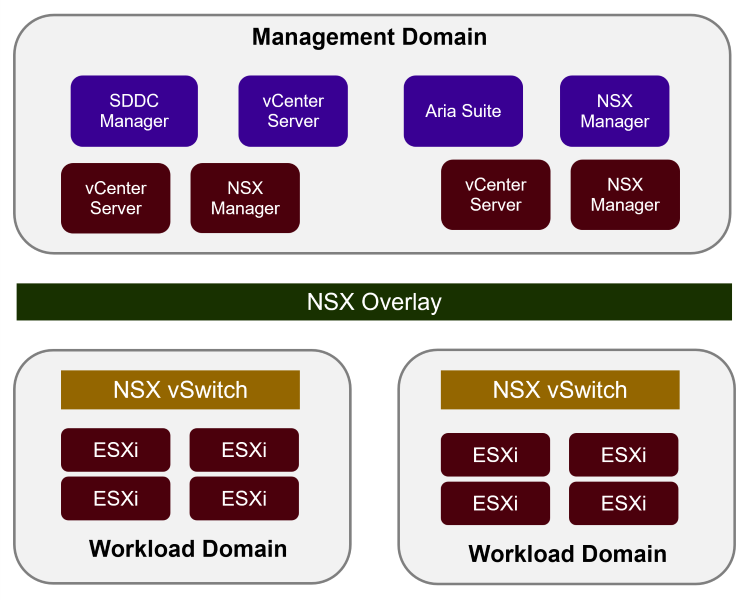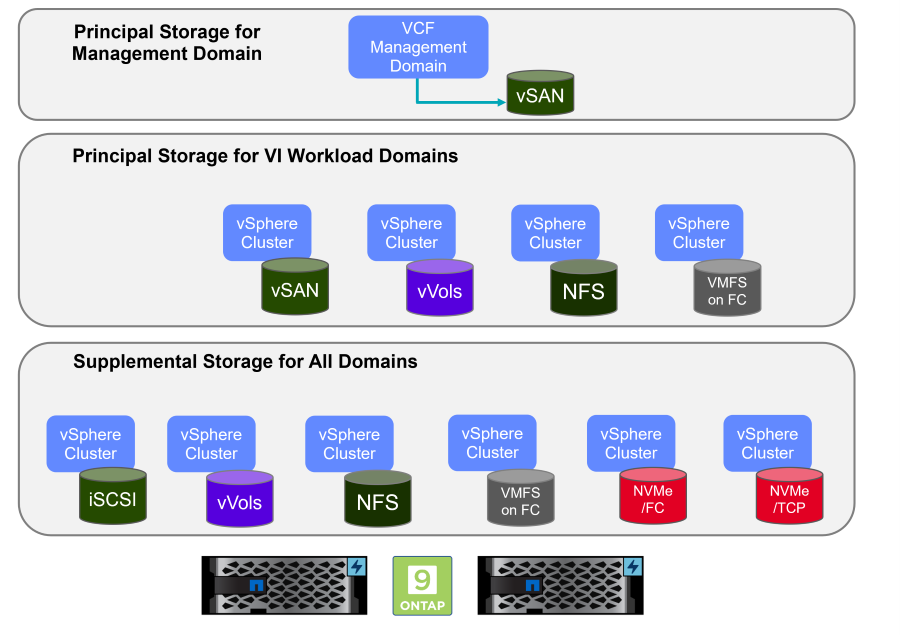VMware Cloud Foundation with NetApp All-Flash SAN Arrays
 Suggest changes
Suggest changes


VMware Cloud Foundation (VCF) is an integrated software defined data center (SDDC) platform that provides a complete stack of software-defined infrastructure for running enterprise applications in a hybrid cloud environment. It combines compute, storage, networking, and management capabilities into a unified platform, offering a consistent operational experience across private and public clouds.
Author: Josh Powell
This document provides information on storage options available for VMware Cloud Foundation using the NetApp All-Flash SAN Array. Supported storage options are covered with specific instruction for deploying iSCSI datastores as supplemental storage for management domains and both vVol (iSCSI) and NVMe/TCP datastores as supplemental datastores for workload domains. Also covered is data protection of VMs and datastores using SnapCenter for VMware vSphere.
Use Cases
Use cases covered in this documentation:
-
Storage options for customers seeking uniform environments across both private and public clouds.
-
Automated solution for deploying virtual infrastructure for workload domains.
-
Scalable storage solution tailored to meet evolving needs, even when not aligned directly with compute resource requirements.
-
Deploy supplemental storage to management and VI workload domains using ONTAP Tools for VMware vSphere.
-
Protect VMs and datastores using the SnapCenter Plug-in for VMware vSphere.
Audience
This solution is intended for the following people:
-
Solution architects looking for more flexible storage options for VMware environments that are designed to maximize TCO.
-
Solution architects looking for VCF storage options that provide data protection and disaster recovery options with the major cloud providers.
-
Storage administrators wanting specific instruction on how to configure VCF with principal and supplemental storage.
-
Storage administrators wanting specific instruction on how to protect VMs and datastores residing on ONTAP storage.
Technology Overview
The VCF with NetApp ASA solution is comprised of the following major components:
VMware Cloud Foundation
VMware Cloud Foundation extends VMware’s vSphere hypervisor offerings by combining key components such as SDDC Manager, vSphere, vSAN, NSX, and VMware Aria Suite to create a software-defined datacenter.
The VCF solution supports both native Kubernetes and virtual machine-based workloads. Key services such as VMware vSphere, VMware vSAN, VMware NSX-T Data Center, and VMware Aria Cloud Management are integral components of the VCF package. When combined, these services establish a software-defined infrastructure capable of efficiently managing compute, storage, networking, security, and cloud management.
VCF is comprised of a single management domain and up to 24 VI workload domains that each represent a unit of application-ready infrastructure. A workload domain is comprised of one or more vSphere clusters managed by a single vCenter instance.

For more information on VCF architecture and planning, refer to Architecture Models and Workload Domain Types in VMware Cloud Foundation.
VCF Storage Options
VMware divides storage options for VCF into principal and supplemental storage. The VCF management domain must use vSAN as its principal storage. However, there are many supplemental storage options for the management domain and both principal and supplemental storage options available for VI workload domains.

Principal Storage for Workload Domains
Principal storage refers to any type of storage that can be directly connected to a VI workload domain during the setup process within SDDC Manager. Principal storage is deployed with SDDC manager as part of cluster creation orchestration and is the first datastore configured for a workload domain. It includes vSAN, vVols (VMFS), NFS and VMFS on Fibre Channel.
Supplemental Storage for Management and Workload Domains
Supplemental storage is the storage type that can be added to the management or workload domains at any time after the cluster has been created. Supplemental storage represents the widest range of supported storage options, all of which are supported on NetApp ASA arrays. Supplemental storage can be deployed using ONTAP Tools for VMware vSphere for most storage protocol types.
Additional documentation resources for VMware Cloud Foundation:
* VMware Cloud Foundation Documentation
* Supported Storage Types for VMware Cloud Foundation
* Managing Storage in VMware Cloud Foundation
NetApp All-Flash SAN Arrays
The NetApp All-Flash SAN Array (ASA) is a high-performance storage solution designed to meet the demanding requirements of modern data centers. It combines the speed and reliability of flash storage with NetApp's advanced data management features to deliver exceptional performance, scalability, and data protection.
The ASA lineup is comprised of both A-Series and C-Series models.
The NetApp A-Series all-NVMe flash arrays are designed for high-performance workloads, offering ultra-low latency and high resiliency, making them suitable for mission-critical applications.

C-Series QLC flash arrays are aimed at higher-capacity use cases, delivering the speed of flash with the economy of hybrid flash.

For detailed information see the NetApp ASA landing page.
Storage Protocol Support
The ASA supports all standard SAN protocols including, iSCSI, Fibre Channel (FC), Fibre Channel over Ethernet (FCoE), and NVME over fabrics.
iSCSI - NetApp ASA provides robust support for iSCSI, allowing block-level access to storage devices over IP networks. It offers seamless integration with iSCSI initiators, enabling efficient provisioning and management of iSCSI LUNs. ONTAP's advanced features, such as multi-pathing, CHAP authentication, and ALUA support.
For design guidance on iSCSI configurations refer to the SAN Configuration reference documentation.
Fibre Channel - NetApp ASA offers comprehensive support for Fibre Channel (FC), a high-speed network technology commonly used in storage area networks (SANs). ONTAP seamlessly integrates with FC infrastructure, providing reliable and efficient block-level access to storage devices. It offers features like zoning, multi-pathing, and fabric login (FLOGI) to optimize performance, enhance security, and ensure seamless connectivity in FC environments.
For design guidance on Fibre Channel configurations refer to the SAN Configuration reference documentation.
NVMe over Fabrics - NetApp ONTAP and ASA support NVMe over fabrics. NVMe/FC enables the use of NVMe storage devices over Fibre Channel infrastructure, and NVMe/TCP over storage IP networks.
For design guidance on NVMe refer to NVMe configuration, support and limitations
Active-active technology
NetApp All-Flash SAN Arrays allows for active-active paths through both controllers, eliminating the need for the host operating system to wait for an active path to fail before activating the alternative path. This means that the host can utilize all available paths on all controllers, ensuring active paths are always present regardless of whether the system is in a steady state or undergoing a controller failover operation.
Furthermore, the NetApp ASA offers a distinctive feature that greatly enhances the speed of SAN failover. Each controller continuously replicates essential LUN metadata to its partner. As a result, each controller is prepared to take over data serving responsibilities in the event of a sudden failure of its partner. This readiness is possible because the controller already possesses the necessary information to start utilizing the drives that were previously managed by the failed controller.
With active-active pathing, both planned and unplanned takeovers have IO resumption times of 2-3 seconds.
For more information see TR-4968, NetApp All-SAS Array – Data Availability and Integrity with the NetApp ASA.
Storage guarantees
NetApp offers a unique set of storage guarantees with NetApp All-flash SAN Arrays. The unique benefits include:
Storage efficiency guarantee: Achieve high performance while minimizing storage cost with the Storage Efficiency Guarantee. 4:1 for SAN workloads.
6 Nines (99.9999%) data availability guarantee: Guarantees remediation for unplanned downtime in excess of 31.56 seconds per year.
Ransomware recovery guarantee: Guaranteed data recovery in the event of a ransomware attack.
See the NetApp ASA product portal for more information.
NetApp ONTAP Tools for VMware vSphere
ONTAP Tools for VMware vSphere allows administrators to manage NetApp storage directly from within the vSphere Client. ONTAP Tools allows you to deploy and manage datastores, as well as provision vVol datastores.
ONTAP Tools allows mapping of datastores to storage capability profiles which determine a set of storage system attributes. This allows the creation of datastores with specific attributes such as storage performance and QoS.
ONTAP Tools also includes a VMware vSphere APIs for Storage Awareness (VASA) Provider for ONTAP storage systems, which enables the provisioning of VMware Virtual Volumes (vVols) datastores, creation and use of storage capability profiles, compliance verification, and performance monitoring.
For more information on NetApp ONTAP tools see the ONTAP tools for VMware vSphere Documentation page.
SnapCenter Plug-in for VMware vSphere
The SnapCenter Plug-in for VMware vSphere (SCV) is a software solution from NetApp that offers comprehensive data protection for VMware vSphere environments. It is designed to simplify and streamline the process of protecting and managing virtual machines (VMs) and datastores. SCV uses storage based snapshot and replication to secondary arrays to meet lower recovery time objectives.
The SnapCenter Plug-in for VMware vSphere provides the following capabilities in a unified interface, integrated with the vSphere client:
Policy-Based Snapshots - SnapCenter allows you to define policies for creating and managing application-consistent snapshots of virtual machines (VMs) in VMware vSphere.
Automation - Automated snapshot creation and management based on defined policies help ensure consistent and efficient data protection.
VM-Level Protection - Granular protection at the VM level allows for efficient management and recovery of individual virtual machines.
Storage Efficiency Features - Integration with NetApp storage technologies provides storage efficiency features like deduplication and compression for snapshots, minimizing storage requirements.
The SnapCenter Plug-in orchestrates the quiescing of virtual machines in conjunction with hardware-based snapshots on NetApp storage arrays. SnapMirror technology is utilized to replicate copies of backups to secondary storage systems including in the cloud.
For more information refer to the SnapCenter Plug-in for VMware vSphere documentation.
BlueXP integration enables 3-2-1 backup strategies that extend copies of data to object storage in the cloud.
For more information on 3-2-1 backup strategies with BlueXP visit 3-2-1 Data Protection for VMware with SnapCenter Plug-in and BlueXP backup and recovery for VMs.
Solution Overview
The scenarios presented in this documentation will demonstrate how to use ONTAP storage systems as supplemental storage for management and workload domains. In addition, the SnapCenter Plug-in for VMware vSphere is used to protect VMs and datastores.
Scenarios covered in this documentation:
-
Use Ontap Tools to deploy iSCSI datastores in a VCF management domain. Click here for deployment steps.
-
Use Ontap Tools to deploy vVols (iSCSI) datastores in a VI workload domain. Click here for deployment steps.
-
Configure NVMe over TCP datastores for use in a VI workload domain. Click here for deployment steps.
-
Deploy and use the SnapCenter Plug-in for VMware vSphere to protect and restore VMs in a VI workload domain. Click here for deployment steps.

